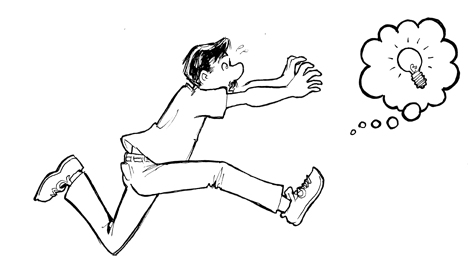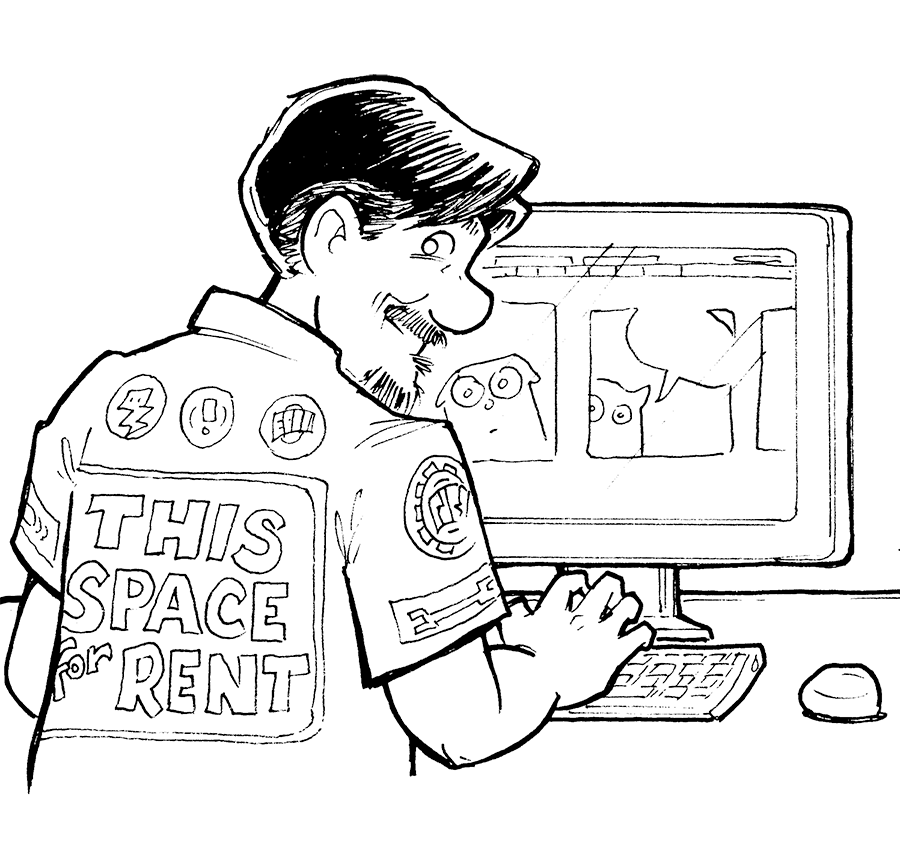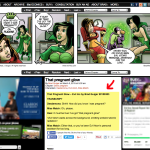You don’t need a subscription to read today’s post!
This is a re-post from the Webcomics.com archive. If you’ve ever been curious about the kind of information, tutorials and advice that you’ll get as part of your subscription to Webcomics.com, this is a good example.
If you’d like to join the site, you can get a 12-month subscription for $30 — or you can get a one-month Trial for $5 … with no obligation after your 30 days expire. For less than three bucks a month, you can get a steady flow of information, tutorials and advice targeted towards your webcomic business — plus a private forum to discuss issues with other professionally minded cartoonists.
This was originally offered by Phil Hofer in the forum, but I wanted to pull it out here to make it easier to find in case anyone was looking for this answer later.
Is there any advantage to using Comic Easel’s Transcript function to input comic’s script. Does it provide any SEO advantage?
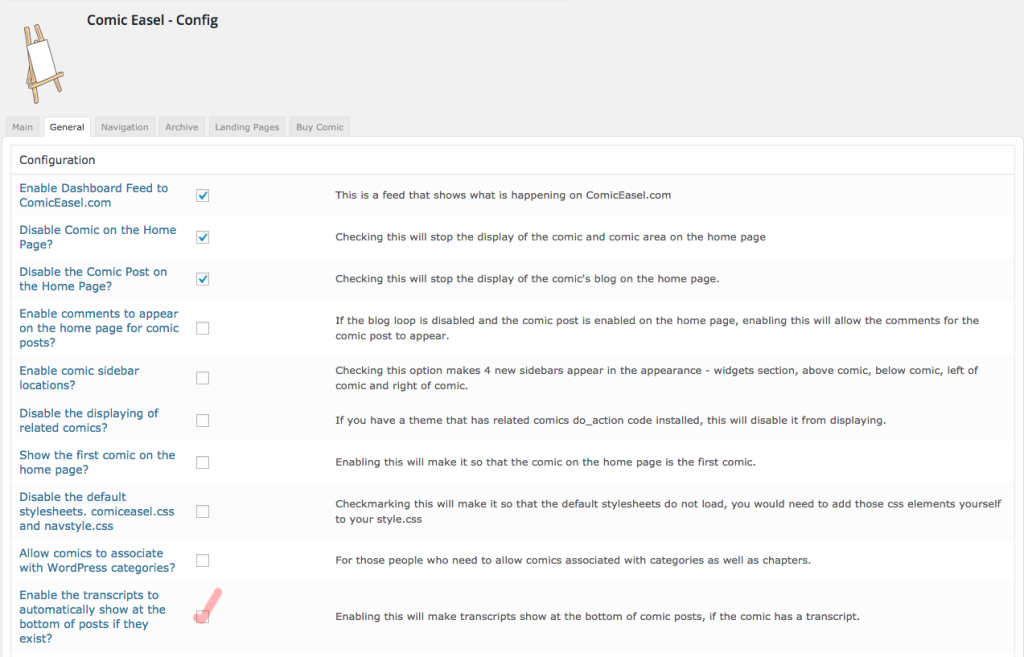
From Philip: “No advantage, it’s actually more advantageous to have it in the post area of the article. It’s primarily visual in context only. And it doesn’t use it as classification unless proper google attributes are set to it, in that case it’s again, better to add the transcript to the post [in the blog]. It was kept where it is as part of the backwards compatibility with users of old ComicPress when Google didn’t mind it being as a meta-influenced tag set as it is. However, since then Google has made changes that would make it beneficial to you to have it as part of the post.”
See, that’s the major drawback to webcomics from a Web-advertising perspective, even if you generate daily, original content, it’s invisible to ad networks because it can’t be spidered.
One way to get around this is to place the transcript of the comic in the blog. And that’s a pretty good solution — except for the fact that it discourages your readers from reading the blog (“Wait… I already read this!”) and it will clutter your RSS feed (if both the comic and the blog appear in the feed — which they should).
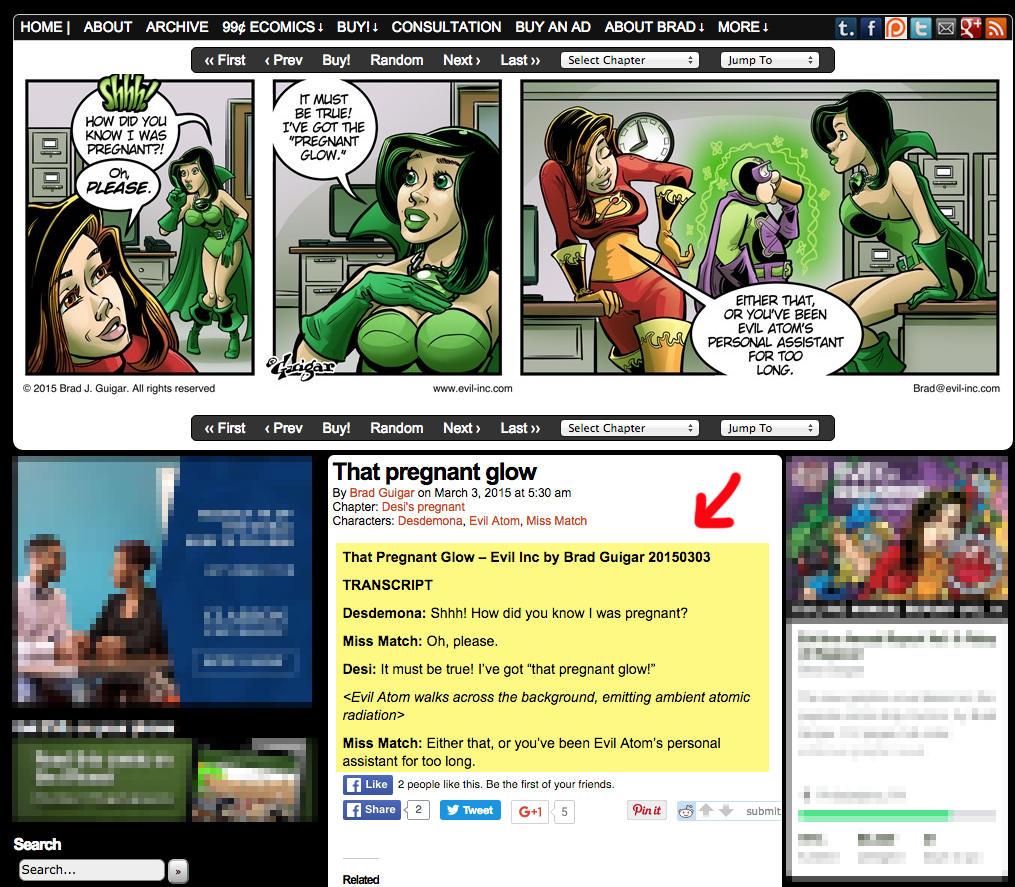
I’ve heard of some cartoonists who try to get around this by hiding the transcript on their page. They’ll put it at the bottom of the page or they’ll run it in black on top of a black background somewhere on the page. I’m not sure either of these are good options.
If you’re trying to get searchable type on your page to increase your value to an ad network, I think using the comic transcript is not your best option.
Instead, you should be using that blog for what it’s for — building community by talking with your readers. I’ve become a huge believer in frequent blogging under the comic. I was always a proponent from the standpoint of community-building, but having seen the effect that frequent blogging has done for my ad revenue, I’m even more strongly in favor of using that blog to its fullest extent.
It’s a win-win for you. You’re building community and increasing your value to your ad network — both of which puts more money in your pocket.
SEO blogging
 Recently, I’ve been rededicating my efforts towards my blog — not by placing the transcript there, but by doing some actual blogging (click on the image to the right to see a full-size example).
Recently, I’ve been rededicating my efforts towards my blog — not by placing the transcript there, but by doing some actual blogging (click on the image to the right to see a full-size example).
It should be noted that Yoast’s plug-in applies itself to every post type — pages, posts, podcasts, and even comics. So, in the same way that you should prepare an SEO profile for a blog post, you should prep one for every comic you upload.
Filling out the form is pretty straightforward is you keep in mind one thing: Everything hinges on the keyword (or words).
So your SEO is going to improve the more consistently that keyword shows up in certain places on your site. And that’s what Yoast does. It reminds you to put the keyword in your title, in the meta description, in the page URL, in the blog itself, and so on.
Here’s the form filled out for the example from above.
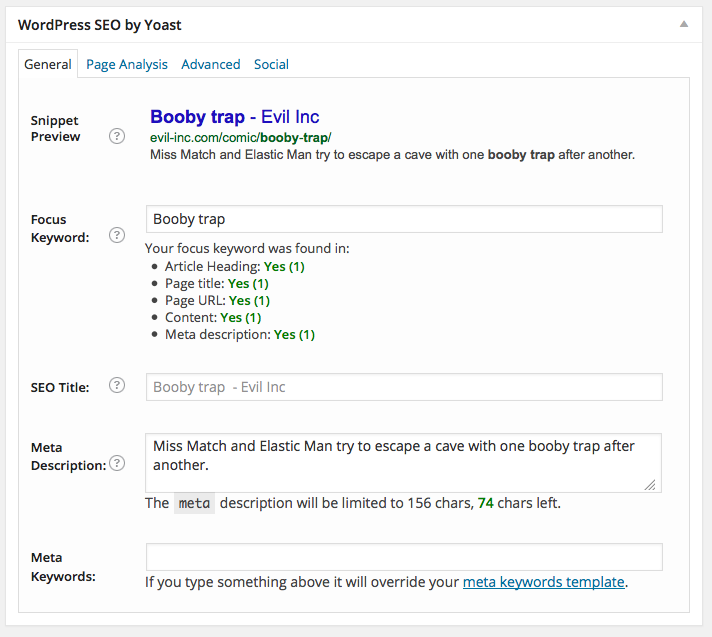
As you’ll note from the above graphic, I’ll get a green-text approval for each one of these categories I satisfy.
Heck, I even put my keyword in the Alt text for the comic’s image file.
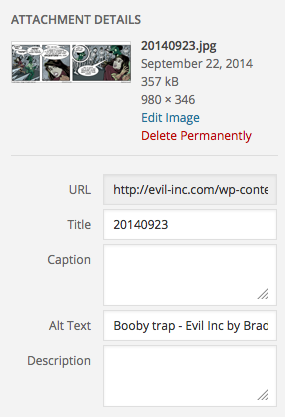
Now, here’s where I think a lot of people go wrong
It’s all in the comic title. Being the creative types we are, we feel the need to come up with a clever title. But this is the last place to be clever! In fact, I’ll argue that this is the place to be as un-creative as possible — or maybe, just creative in a different way.
Because that title has to feature a keyword. And that keyword is the word that you expect people to punch into a search-engine field and (hopefully) find your comic.
And if your keyword (and, therefore, title) features a cute play on words, the chances diminish that someone would use that phrase in a search.
Let me give you an example.
I’m uploading this comic…
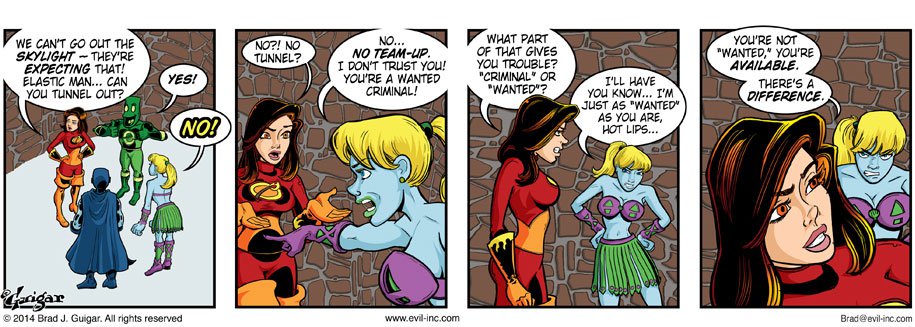
Now, I have my choice of several keywords. I chose “Most Wanted.”
Why?
Because (A) it applies to the comic, and (B) it’s a phrase that I assume would be used in several search-engine searches.
One of my readers noticed this. (They can see the title and the transcript in that day’s comic’s arhive page.)
I love this, but the fact that this update wasn’t titled “Burn” or something along those lines disappoints me a little. And I mean that in the nicest way if that’s possible.
It’s understandable. They’re certainly not thinking SEO as they’re enjoying the Web site.
And, to be fair, “burn” would have been an acceptable title, too.
What wouldn’t have been acceptable would have been a play on words such as “America’s Least Wanted” or “Burnabout is fair play.”
Those are much more clever headlines, but there’s a much more slim chance that people will put them into a search-engine search. And SEO hinges on exactly that process.
So my headlines are always plane-jane keyword headlines that are chosen on the basis of words and phrases that I judge to be common search terms.
I’m not counting on their entertainment value. The words don’t appear on the main page (and they’re an afterthought on the archive pages). And my comic is plenty entertaining without cute titles. That’s not a job that I want them to do. The role those words play on my site is pure-and-simple SEO.
What do I blog about?
The answer to the above question, in my opinion, is yes. With an asterisk.
See, the reason the blog is so powerful is that it’s one of the strongest tools you have in building your community. In the blog, your choice of topics tells your readers what this site is about, who you are, and most importantly, what this community is about. Your choice of topics will make members of your community feel welcome, intrigue them, and encourage them to become more active on your site.
So, you certainly can post work of your own that is unrelated to the strip itself. After all, it’s your work. And you’re sharing something that helps describe who you are.
However, this cannot replace or stand in the way of the overall community-building effort you’re making in that blog.
So, if the coloring samples are sprinkled in among a liberal sampling of other posts that help to focus your site, then I say go for it.
However, if these posts are part or a jumbled mess of “I don’t know what else to do” posts, then you have to do a lot more thinking about who your readers are — and what do you have to do to make them feel like your site is their home.
Directing attention to your blog
And let’s face it, even if your blog is first-screen maximized, all of the action takes place in the area the comic inhabits. The vast majority of your readers are going to zoom in on the space and then zoom out. Your challenge is to try to catch their attention in that nanosecond between the last panel and their departure — and direct it to the blog.
Here’s a good strategy for doing just that.
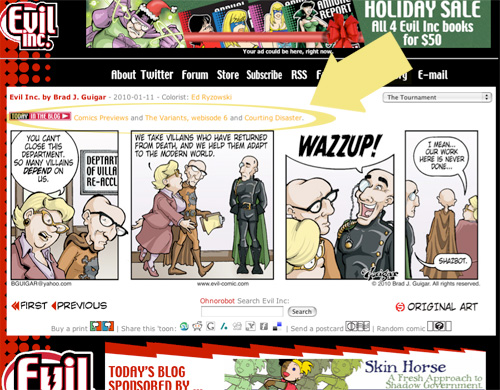
A named anchor tag is a short piece of HTML code that, when clicked, scrolls the user’s browser to a specific place on the page. It has two parts, the anchor and the target. The anchor behaves like a standard hyperlink, but when it is clicked, it scrolls to where you’ve placed the target.
I used to set my blog up in the following manner. I had a JPEG that I use as a header. It indicates that there’s a blog below the image. In my case, it says, “Today’s Blog Sponsored By…” and runs side-by-side with an ad. The JPEG never changes — just the text underneath as I update the blog.
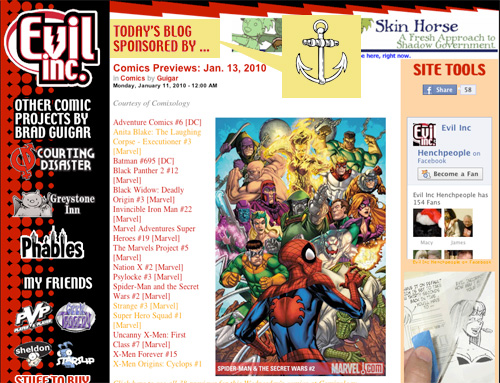
I have the target code — <a id=”blog”></a> — set around that JPEG.
The “blog” part can be any word. You could just as easily choose <a id=”methusela”></a>. But what ever you choose, you’re going to have to use exactly the same word in the anchor code.
The anchor code looks like this: <a href=”index.html#blog”>this can be any text</a>
Inside the parenthesis, you’ll pair the name of the page you have the target placed on — in this case it’s my index.html page. Then a number sign — #. Then the word you’re using in the target — in this case it’s blog.
Directing traffic on-site
I have a small, unobtrusive line of text directly above the comic. It features a small art element that says: Today in the Blog. And following that lead-in, I have a simple line of hyperlinked text with headline-style teases to the top three topics in the blog. Each of the teases is hyperlinked with an anchor link — <a href=”index.html#blog”>
Now, whenever I update my blog, I take a moment to manually change the teases above the comic. When a reader clicks on the link, it scoots them right down to the blog.
I’ve seen a lot of success in this strategy. In a recent reader survey, I asked my readers how often they read the Evil Inc blog. The majority of respondents said “Two-to-three times a week.” After that was “daily” and then “once a week.” Some people responded “Seldom.” And one person responded “Never.”
Incidentally, the only place I announced the readership survey was in the blog.
But the central message was clear. The site does a decent job of directing traffic down the page. And, in part, I think I have those anchor tags to thank for that.
Directing traffic from off-site
If you’re using that blog for all it’s worth, it quickly grows from being some kind of auxiliary function of your site, and you’ll find that you’re writing stuff down that that you want readers to know about just as much as you want them to know about your comic.
I use the anchor tags when I’m promoting my blog from off-site as well. For example, when I tweet about a blog update, I’ll link to http://www.evil-comic.com/#blog — which loads the page and immediately snaps it down to the appropriate target.

